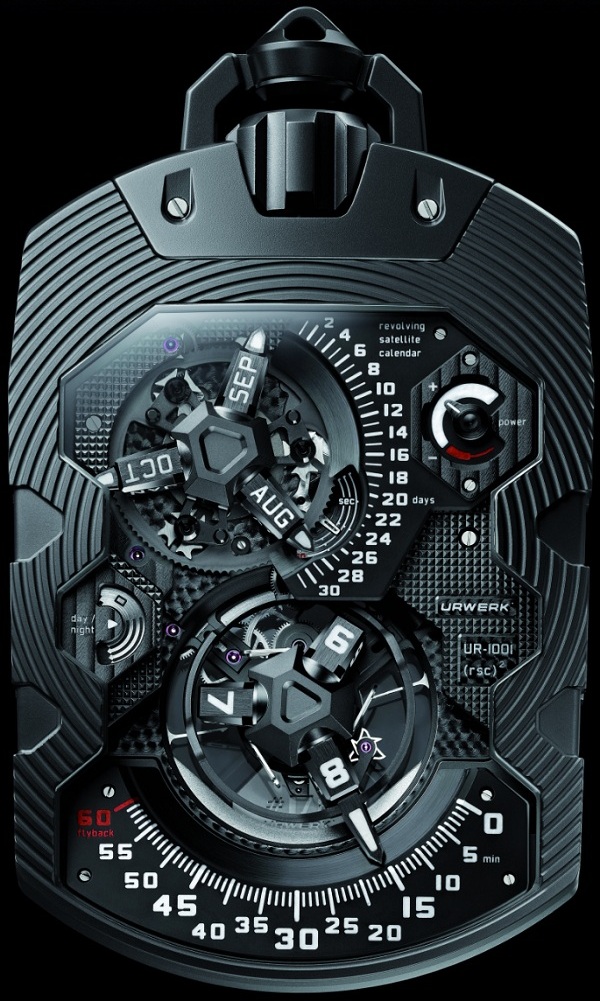
Someone recently asked me whether they thought pocket watches might come back in fashion. John and I spent time discussing this during an episode of the HourTime Show watch podcast and after giving it much thought the answer was a resounding “not likely.” So why am I mentioning this before I discuss what is arguably one of the coolest pocket watches around? Because this pocket watch you see before you won’t find a place in jacket pockets and be used to tell the time on a regular basis. It will be stored sweetly and safely and played with from time to time. The privileged few owners of these watches will still use a wrist watch as their primary (or at least secondary) means of telling the time. This and other pocket watches will merely be a collector’s item. Possibly really cool collector’s items, but still just that.
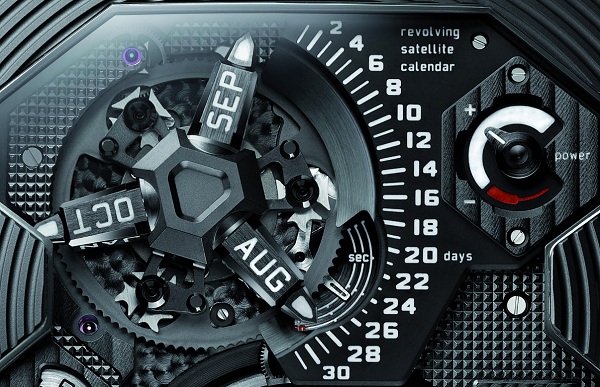
Pocket watches are increasingly attractive for high-end brands to make as limited edition models because of collective nostalgia and size. In 1989 Patek Philippe released its famous “Calibre 89” pocket watch. At the time it was the most complicated timepiece in the world. Patek isn’t really in the market to make pocket watches but the size of a pocket watch allows sophisticated brands to show off their stuff. You can simply fit a lot more in to something the size of a pocket watch versus a wrist watch. For mechanical junkies like me, the allure of shoving in “the whole kitchen sink” is just to appealing from an aspirational standpoint. That still doesn’t mean I can see myself lugging it around.
A few years ago, the first really modern super high-end pocket watch came out released by Richard Mille. Called the RM 020, its rectangular shaped case defied the round shape rule that we associate with most pocket watches. It cost over $400,000 and contained a tourbillon among other complications. It also had a funky titanium chain that reminded me of robotic dreadlocks. Now Urwerk releases their version of the pocket watch which follows the “it no longer needs to be round” rule.
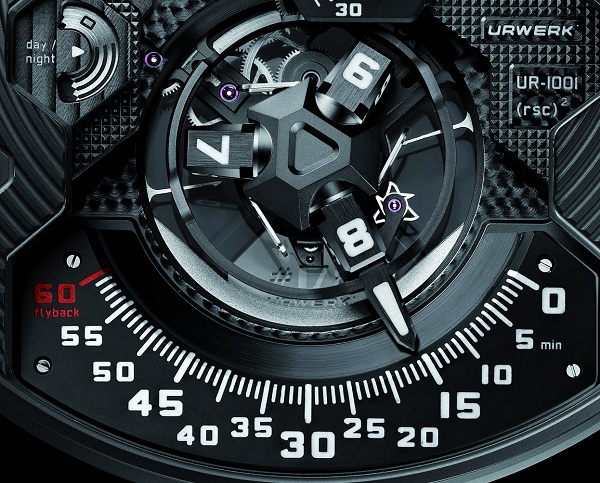
Urwerk doesn’t even call their model UR-1001 a pocket watch. There prefer the term “Zeit Device Über Complication.” That does seem to apply better to something that looks like a watch gear assembled mobile phone. Too bad Celsius sort of beat them to the punch with a high-end watch that actually is in a phone. With the fold out section on the back of the UR-1001 that reminds me of those old Motorola StarTac phones, it is hard to not see the mobile phone connection. Go ahead, try to make a call with it.
Uber device it is. The UR-1001 is basically an accumulation of all of the complications that Urwerk has developed over the years. It then adds a new calendar system. That doesn’t mean the UR-1001 contains every function they’ve put in timepieces, but all the unique elements that make an Urwerk an Urwerk are represented in this pocket watch… I mean this super device awesome complication time munching mega stick.
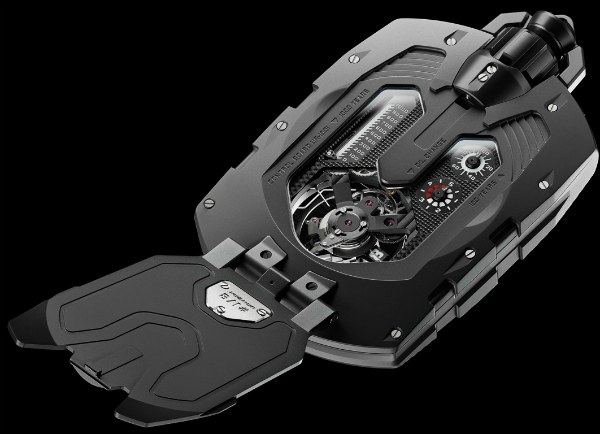
The UR-1001 will initially be made in AlTiN – which is an alloy that uses titanium and aluminum. It is 106mm high and 62mm wide, and only 23mm wide. Of course it comes with a chain to fit the watch made in blackened steel with a carabiner clasp. The initial UR-1001 watch will be made as a limited edition of just 8 pieces. I anticipate that Urwerk will follow up with additional UR-1001 or derivative pocket watches in other materials/colors.
The design of the UR-1001 case is very much inline with the design of Urwerk’s watches. It looks ergonomic from a holding standing point and the large crown is located at the top. If you are familiar with Urwerk timepieces you’ll instantly recognize this as a member of the brand. I overall like how the case acts as a frame for the internal components, but I think that the integration of the screws on the case (especially the back) could have been a bit more refined. On the rear of the UR-1001 is a flap that opens and closes to reveal some of the additional complication.
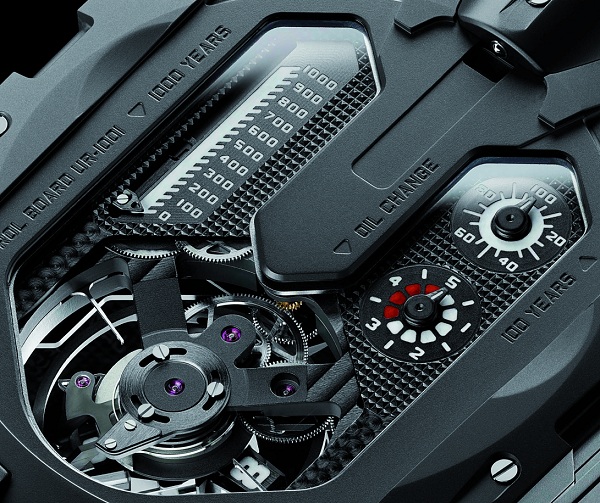
Inside the watch is an Urwerk made caliber UR-10.01 manually wound movement. While there are additional details below, the movement more or less has the time with day/night indicator, power reserve indicator, running time indicator, and an annual calendar. The real innovation is the application of a calender to Urwerk’s satellite system for telling the time. The same method for telling the hours and minutes is now used to indicate the month (or the revolving hands) and the date on the linear scale. For whatever reason the seconds indicator for the time is located in this area.
It would have been really cool to see this calendar be a perpetual calendar – maybe next time. As for super technical innovation, that isn’t really what the UR-1001 is about it seems. It is a pocket watch that wows Urwerk watch lovers by having double satellite systems in a single device – rather than being a showcase for shoving in as many complications as possible. Seeing everything in action is beautiful. The openness of the dial and design are very attractive. One area I wish could have been improved upon is power reserve for the movement, which is only 39 hours. However, Urwerk does supply a display case that includes an automatic winder – more details on that below.
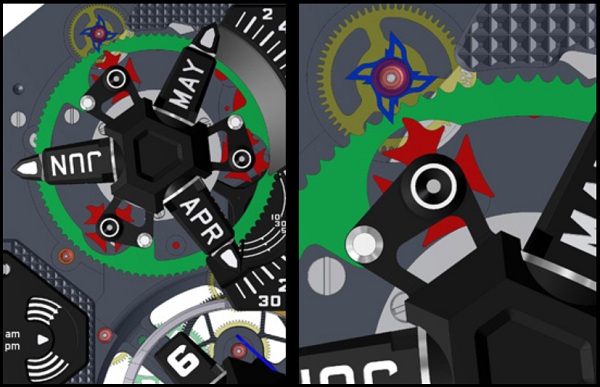
Complimenting the time and calendar functions is Urwerk’s “oil change indicator” and running time indicator. The oil change indicator basically tells you when to send your UR-1001 back to Urwerk for (an expensive) service each 5 years. The running indicator basically measures how long the UR-1001 movement has been operating. Urwerk designed it to go up to 1000 years. Yup. I really admire how much they stand behind their build quality!
Overall, I am impressed by the Urwerk UR-1001 Zeit Device Uber Complication. It isn’t exactly that uber complicated, but it is uber cool. For me it is more about concept and design, as well as being mechanical art. For the few hundred grand it will cost, eight people will be pretty happy. See more details and tech specs below. Urwerk
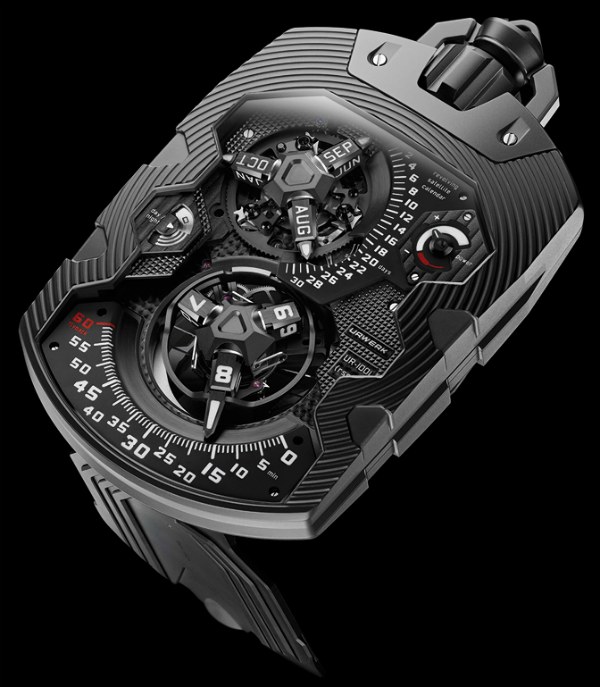
UR-1001 – Complications in Detail Direct From Urwerk:
Dial side
Hour Satellite Complication. The Hour Satellite Complication of the Zeit Device is a ‘flying’ design in that there is no top bridge supporting the carrousel. The mechanism requires a bottom support only, which allows maximum appreciation of the satellite hour and retrograde minute complications.
The complication comprises a rotating central carrousel supporting three hour satellites, each cubic satellite marked with four hour numbers on their four faces. As the carrousel turns, the satellites not telling the time rotate on their vertical axis so that their top number has the new hour ready to replace the old. Hours and minutes are able to be set backwards without affecting the calendar functions.
Retrograde Minute Hand. The Retrograde Minute Hand is fixed to a sprung ring around the circumference of the satellite complication. This ring is pushed along a guide rail by the hour satellite. A swan’s neck spring on each arm of the carrousel engages two coaxial star-cams that slide along the guide rail carrying the minute hand. When the minute hand gets to the end of the rail at 60 minutes, the star-cams trip over to release the minute hand, which springs back to zero at the start of the scale where it rendezvous with the next satellite hour. A small bar of platinum on the sprung ring acts as a counterweight to the minute hand pointer. A safety device ensures that the minute hand cannot rotate past 63 minutes, even in case of a shock.
Day Night and Power Reserve Indicator.
The Day/Night indicator is a rotating disc marked with Black Super-LumiNova for the night, white brushed-ruthenium for day and a striped mix for dusk/dawn. While useful in its own right, the Day/Night indicator comes into its own when setting the calendar mechanism to ensure that the date changes at midnight rather than midday.
The Power Reserve indicator monitors the amount of power in the mainspring up to 39 hours and features a red warning zone to remind the owner when the Zeit Device needs refuelling.
Revolving Satellite Calendar.
The Revolving Satellite Calendar is an original – both technically and graphically – calendar complication completely developed in-house by URWERK. Visually it is in the same family as the hour satellite complication, with months and date replacing hours and retrograde minutes. However, whereas the hours rotate across the minutes with unchanging 60-minute regularity, the month automatically adjusts the last date on the calendar complication according to whether it has 30 or 31 days.
Back side
Turning the UR-1001 over and flipping over the protective cover reveals an alternative universe of longer timescale indications to those on the front. The dominating feature through the display back is the underneath of the hour satellite complication and retrograde minute mechanism, its dark surface set off by bright ruby bearings. The “Oil Change”, 100-year and 1000-year are long-term indications lying under a protective cover on the back of the Zeit Device and are driven by the operation of the movement.
“Oil Change” indicator. The shortest time interval measured on the back is the 5-year “Oil Change” indicator at centre right, which alerts the user when a service is due after three years when the dial changes from white (years one to three) to red (years three to five). This is counter is reset to zero when the timepiece is serviced.
100-year indicator. The 100-year indicator advances in 5-year increments and acts like the odometer of a car. Where a car’s odometer keeps track of the total distance number at vehicle has driven, the 100-year and 1000-year indicators of the UR-1001 register the total running time of the movement.
1000-year indicator. When the hand reaches the 100-year mark, the small pointer at the bottom of the 1000-year indicator on the left takes a small – small for the Zeit Device, but a giant leap for mankind – 100-year step upwards on its imperceptibly slow, but deliberate journey to a new millennium.
Case. The case of the UR-1001 is in AlTiN coated stainless steel. AlTiN – Aluminum Titanium Nitride – is an industrial surface treatment originally developed to reduce the wear of machine cutting tools. The very properties that make AlTiN suitable for industrial applications, e.g. increased oxidation resistance and hardness, coupled with its semi-matte black color make it an ideal high-tech coating to protect the Zeit Device.
Fine finishing. The fine finishing and decoration throughout the case, dials and components of the Zeit Device are a harmonious blend of the contemporary and the traditional, echoing URWERK’s ethos of 21st century watchmaking based on a solid foundation of the very best in traditional horology. Circular lines engraved into the top of the case give hint to the fact that the form of the Zeit Device’s case is actually a circle with cut sides. Clous de Paris guilloche on the dial provides both a rich texture and a pleasing contrast with the flat surfaces on the indications. The satellites and their hands feature diamond-cut bevels that reflect light during the day, while flush embedded white Super-LumiNova ensures legible reading of the time at night. Clous de Paris guilloche surfaces continue on the back of the timepiece and in a tip of the hat to URWERK’s home, Geneva waves (Côtes de Genève) are engraved on sections of the bridge supporting the base of the Hour Satellite Complication.
ARCAP. URWERK is one of a very few watch brands – perhaps the only – making extensive use of ARCAP is their timepieces. ARCAP alloys are a proprietary group of alloys that do not contain iron and so are non magnetic. They have very high tensile strength and they are resistant to oxidation – unlike the commonly used brass that has to be plated – chemical corrosion, low temperatures and are stable under temperature changes. And compared to brass, ARCAP is more stable when machined and does not retain tension, which makes it able to be machined to higher precision. ARCAP’s advantages do not come free of charge and it wears machine tools out at a 5X higher rate than brass. In the UR-1001, the mainplate, baseplate, carrousels, satellites, dials, bridges, retrograde spiral spring and retrograde u-springs are all in ARCAP.
Winder/Display case. The combined automatic winder and display case of the Zeit Device is in polished, solid walnut with buffalo leather lining. The case can sit on a desk with the timepiece securely held (push-fit) in a vertical position with the dial side in full view. Every 10 or 15 minutes – the interval is adjustable according to whether the timepiece requires fast winding or maintaining winding – the Zeit Device is rotated 185° and slowly oscillates to rest, causing a winding rotor to charge the mainspring. Keeping the Zeit Device wound in this way minimizes the necessity of having to reset the calendar functions after the movement has stopped.
UR-1001 – Technical Specifications
Movement
Calibre: UR-10.01
Jewels:51
Escapement: Swiss lever
Balance: Monometallic
Frequency: 28,800v/h, 4Hz
Balance spring: Flat
Power source: Single mainspring barrel
Power reserve: 39 hours
Winding system: Unidirectional winding rotor
Time mechanism: Double star retrograde with aluminium ring and platinum counterweight
Calendar mechanism: 93 tooth wheel, 3 Maltese crosses
Retrograde minutes: Anti-shock safety device
Retrograde minute spring: Spiral of 6.5 turns, dimensions 174.4mm x 0.1mm x 0.3mm with mobile piton (adjustable pin). Long length ensures flat torque curve
Plates and bridges: Baseplate in ARCAP
Screws: Titanium non-oxidising
Surface finishes: Circular-grained, Côtes de Genève and DLC treated mainplate and baseplate, chamfered and polished screw heads
Indications
Dial side Revolving satellite hour complication
Retrograde minutes
Revolving satellite calendar with months and dates
Day/night indicator: black Super-LumiNova for night, white brushed – ruthenium for day, mix for dusk/dawn
Power-reserve indicator 39 hours with red low-power zone
Running seconds: three-handed indication displaying 3 x 20 seconds on a 120° dial
Côtes de Genève on Day/Night and Power Reserve indicator dials
Back side “Oil change” indicator (5 years)
Running-time indicator for 100 years
Linear running-time indicator for 1,000 years
Surface finishes: Sandblasted carousel
PE-CVD and DLC treated mainplate, baseplate, dials and satellite complications
Satin-finished and diamond-polished satellites
Super-LumiNova treatment on markers
Setting and winding: Three-position winding crown
Position 1 against case: winding
Position 2 one click: month and date
Position 3 two clicks: setting hours and minutes
Case
The AlTiN UR-1001 Zeit Device is a limited edition of 8 pieces in AlTiN treated steel with titanium elements.
Material: AlTiN steel with titanium elements
Chain: Hand-made, heat-blackened steel links featuring bespoke URWERKclasp with carbineer closure
Dimensions: 106mm x 62mm x 23mm
Glasses:Sapphire crystal with anti-reflective coating
Water resistance: Pressure-tested to 3ATM
Surface finishes: Micro-sandblasted
